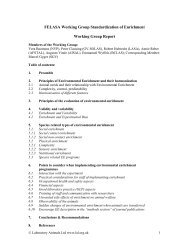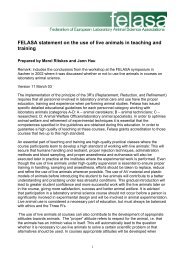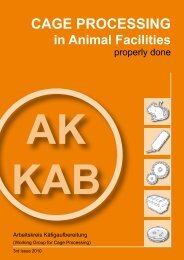CAGE PROCESSING in Animal Facilities - Felasa
CAGE PROCESSING in Animal Facilities - Felasa
CAGE PROCESSING in Animal Facilities - Felasa
- No tags were found...
You also want an ePaper? Increase the reach of your titles
YUMPU automatically turns print PDFs into web optimized ePapers that Google loves.
configurations can thus require <strong>in</strong>dividual program cycles. The effectiveness of them should always be verifiedand each process should ideally be validated. When plann<strong>in</strong>g the mach<strong>in</strong>es, this needs to be taken <strong>in</strong>to account.Cycle developmentThe process parameters of a cycle are adjusted to each lock and its load. The cycle development must be discussedwith the manufacturer of the generator. In order to avoid material damage, clearly visible condensationmust be averted. Please f<strong>in</strong>d below <strong>in</strong>formation on applications (e.g. electronic devices) and cycle-relevantparameters:• Humidity exceed<strong>in</strong>g the saturation level must be avoided (verifiable with mirror / pane test). Room capacity,<strong>in</strong>itial temperature and humidity must be considered.• The H 2O 2<strong>in</strong>jection rate must be adjusted to the absorption rate of the chamber surface and load.• Surface temperature and volume of the items to be gassed <strong>in</strong>fluence the maximum allowable, condensation-freeH 2O 2concentration (too cold surfaces bear a higher condensation risk).• The warm H 2O 2air mixture should be streamed <strong>in</strong>to free space (e.g. from above) <strong>in</strong> order to avoid directcontact with cold surfaces (e. g. walls and doors) result<strong>in</strong>g <strong>in</strong> condensation.• Computers and other electronic devices should be cleaned <strong>in</strong> advance (dust should be removed) and stayswitched on while be<strong>in</strong>g gassed (PC ventilators, fan units, etc. must be on).• Heavy condensation leads to <strong>in</strong>creased H 2O 2consumption, differences <strong>in</strong> concentration distribution, <strong>in</strong>creasedrisk of material damage, and a longer ventilation time.• Pre-heat<strong>in</strong>g long supply pipes can help avoid heavy condensation.Proof of efficacy / validationThe distribution of H 2O 2concentration is tested with a colour change of chemical <strong>in</strong>dicators. A visual verificationthrough an <strong>in</strong>spection w<strong>in</strong>dow can be made while the process is runn<strong>in</strong>g.The microbiological efficacy is verified by use of biological <strong>in</strong>dicators, usually H 2O 2gass<strong>in</strong>g-suited spore strips(Geobacillus stearothermophilus) hold<strong>in</strong>g a population of 10 5 to 10 6 . When agreed upon with the operator,other organisms (e.g. Bacillus subtilis, Enterococcus faecium) can be used for verification, too. At least six ofthese biological <strong>in</strong>dicators per m³ spatial volume must be placed at crucial po<strong>in</strong>ts <strong>in</strong>side the lock.4.6.2.4 Processual documentationThe H 2O 2generator should automatically compile a cycle record. Accord<strong>in</strong>g to GLP, document<strong>in</strong>g is necessaryfor assign<strong>in</strong>g a given item <strong>in</strong> the process<strong>in</strong>g procedure to a recorded cycle. The cycle record should conta<strong>in</strong><strong>in</strong>formation on temperature, relative humidity, air flow, operator, date, time, <strong>in</strong>jection time and rate, ventilationtime, total consumption of H 2O 2per cycle phase, time sequence, selected gass<strong>in</strong>g program, notices of malfunction,and release.4.6.3 Requirements of process<strong>in</strong>g procedures by means of peracetic acidProcedures us<strong>in</strong>g peracetic acid (PAA) have become less important and are often replaced by H 2O 2procedures.Below you will f<strong>in</strong>d essential <strong>in</strong>formation on the effectiveness and suitability as well as limitation of PAAfor sanitization <strong>in</strong> locks.Sanitization with peracetic acidSanitization with PAA is a wet procedure that is only suited for items with a non porous surface. PAA is a highlyeffective dis<strong>in</strong>fectant with highly oxidis<strong>in</strong>g characteristics. For a safe handl<strong>in</strong>g of PAA, please consult therespective work safety data sheets (please pay attention to the safety data sheets of the manufacturer). A lowconcentration of PAA (0.5 – 1.5 %) <strong>in</strong>activates spores, bacteria, viruses, and fungi at a low temperature of 4 to20 °C.PAA <strong>in</strong> diluted solution consists of a balance of H 2O 2and acetic acid. Therefore, the limit levels of H 2O 2(1 ppm)and acetic acid (10 ppm) are of crucial <strong>in</strong>terest. When there is no noticeable acetic acid odour, it is safe to saythat the air value limits are with<strong>in</strong> normal range. If the ventilation is <strong>in</strong>sufficient, however, visible residues canoccur.Cage Process<strong>in</strong>g <strong>in</strong> <strong>Animal</strong> <strong>Facilities</strong> · 4th issue · 2013 35






